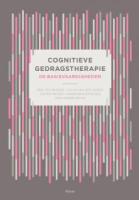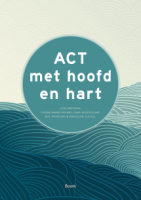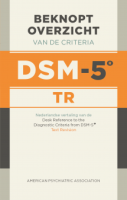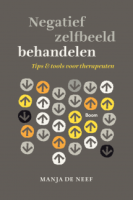Inhoud
Bloosangst: onderliggende mechanismen en daarop gebaseerde interventies
Samenvatting
Mensen met bloosangst vormen een heterogene groep waarvan een groot deel ook voldoet aan de criteria van een sociale angststoornis maar een deel ook niet. Bloosangst gaat vaak gepaard met pervasief vermijdingsgedrag en het gebruik van disfunctioneel veiligheidsgedrag om te voorkomen dat anderen het blozen kunnen zien. De lijdensdruk kan groot zijn en een groeiende groep bloosangstigen kiest voor een drastische chirurgische oplossing om van hun blozen af te komen. Verschillende processen kunnen bijdragen aan het ontstaan en voortduren van de angst. Zo kan het gevoel te blozen negatieve gedachten uitlokken over de gevolgen van het blozen. Deze negatieve gedachten kunnen leiden tot angst, hetgeen op zijn beurt weer kan zorgen voor een versterking van de aandacht voor de bron van angst: het blozen. De kans om in zo’n negatieve spiraal verstrikt te raken is waarschijnlijk groot voor bloosangstigen omdat zij de intensiteit van hun blozen overschatten en in sommige situaties ook daadwerkelijk meer en/of sneller lijken te blozen. Dit artikel bespreekt de empirische evidentie voor deze verschillende processen in samenhang met de klinische implicaties.
Literatuur
- Amies, P., Gelder, M., & Shaw, P. (1983). Social phobia: A comparative clinical study. The British Journal of Psychiatry, 142, 174-179.
- Bögels, S.M. (2006). Task concentration training versus applied relaxation, in combination with cognitive therapy, for social phobia patients with fear of blushing, trembling, and sweating. Behaviour Research and Therapy, 44, 1199-1210.
- Bögels, S.M., Alberts, M., & Jong, P.J. de (1996). Self-consciousness, self-focused attention, blushing propensity and fear of blushing. Personality and Individual Differences, 21, 573-581.
- Bögels, S.M., & Lamers, C.T. (2002). The causal role of self-awareness in blushing-anxious, socially-anxious and social phobics individuals. Behaviour Research and Therapy, 40, 1367-1384.
- Bögels, S.M., Mulkens, S., & Jong, P.J. de (1997). Practitioner task concentration report training and fear of blushing. Clinical Psychology and Psychotherapy, 4, 251-258.
- Bögels, S.M., Rijsemus, W., & Jong, P.J. de (2002). Self-focused attention and social anxiety: The effects of experimentally heightened self-awareness on fear, blushing, cognitions, and social skills. Cognitive Therapy and Research, 26, 461-472.
- Bögels, S.M., & Voncken, M. (2008). Social skills training versus cognitive therapy for social anxiety disorder characterized by fear of blushing, trembling, or sweating. International Journal of Cognitive Therapy, 1, 138-150.
- Bögels, S.M., & Reith, W. (1999). Validity of two questionnaires to assess social fears: The dutch social phobia and anxiety inventory and the blushing, trembling and sweating questionnaire. Journal of Psychopathology and Behavioral Assessment, 21, 51-66.
- Bouwer, C., & Stein, D. J. (1998). Hyperresponsivity to nicotinic acid challenge in generalized social phobia: A pilot study. European Neuropsychopharmacology, 8, 311-313.
- Capozzoli, M.C., Vonk, I.J.J., Bögels, S.M.,& Hofmann, S. (2012). Psychological interventions for fear of blushing. In R. W. Crozier & P. J. de Jong (Eds.), The psychological significance of the blush (pp. 286-304). Cambridge, England: Cambridge University Press.
- Castelfranchi, C., & Poggi, I. (1990). Blushing as a discourse: Was darwin wrong. In W.R. Crozier (ed.). Shyness and Embarrassment: Perspectives from Social Psychology (p. 230251). Cambridge UK: Cambridge University Press.
- Chaker, S., Hofmann, S.G., & Hoyer, J. (2010). Can a one-weekend group therapy reduce fear of blushing? results of an open trial. Anxiety, Stress, & Coping, 23, 303-318.
- Clerkin, E.M., & Teachman, B.A. (2010). Training implicit social anxiety associations: An experimental intervention. Journal of Anxiety Disorders, 24, 300-308.
- Crozier, W.R. (2004). Self-consciousness, exposure, and the blush. Journal for the Theory of Social Behaviour, 34, 1-17.
- Crozier, W.R. (2006). Blushing and the social emotions: The self unmasked. New York: Palgrave Macmillian.
- Crozier, W.R., & Russell, D. (1992). Blushing, embarrassability and self-consciousness. British Journal of Social Psychology, 31, 343-349.
- Dijk, C., Buwalda, F.M., & Jong, P.J. de (2012). Dealing with fear of blushing: A psycho educational group intervention for fear of blushing. Clinical Psychology & Psychotherapy. 19, 481-487.
- Dijk, C., & Jong, P.J. de (2009). Fear of blushing: No overestimation of negative anticipated interpersonal effects, but a high-subjective probability of blushing. Cognitive Therapy and Research, 33, 59-74.
- Dijk, C., & Jong, P.J. de (2011). Blushing-fearful individuals overestimate the costs and probability of their blushing. Behaviour Research and Therapy, 50, 158-162.
- Dijk, C., Jong, P.J. de, Müller, E., & Boersma, W. (2010). Blushing-fearful individuals' judgmental biases and conditional cognitions: An internet inquiry. Journal of Psychopathology and Behavioral Assessment, 32, 264-270.
- Dijk, C., Jong, P.J. de, & Peters, M.L. (2009). The remedial value of blushing in the context of transgressions and mishaps. Emotion, 9, 287-291.
- Dijk, C., Jong, P.J. de, & Peters, M.L. (2013). Social anxiety with fear of blushing: The role of attributing relatively restrictive standards to others. Manuscript ter publicatie aangeboden.
- Dijk, C., Koenig, B., Ketelaar, T., & Jong, P.J. de (2011). Saved by the blush: Being trusted despite defecting. Emotion, 11, 313-319.
- Dijk, C., Voncken, M.J., & Jong, P.J. de (2009). I blush, therefore I will be judged negatively: Influence of false blush feedback on anticipated others' judgments and facial coloration in high and low blushing-fearfuls. Behaviour Research and Therapy, 47, 541-547.
- Domschke, K., Stevens, S., Beck, B., Baffa, A., Hohoff, C., Deckert, J., & Gerlach, A.L. (2009). Blushing propensity in social anxiety disorder: Influence of serotonin transporter gene variation. Journal of Neural Transmission, 116, 663-666.
- Drummond, P.D. (1997). Correlates of facial flushing and pallor in anger-provoking situations. Personality and Individual Differences, 23, 575-582.
- Drummond, P.D., Back, K., Harrison, J., Dogg Helgadottir, F., Lange, B., Lee, C., Leavy, K. Novatscou, C., Pham, H., Prance, J., Radford, D., & Wheatly, L. (2007). Blushing during social interactions in people with a fear of blushing. Behaviour Research and Therapy, 45, 1601-1608.
- Drummond, P.D., & Lazaroo, D. (2012). The effect of niacin on facial blood flow in people with an elevated fear of negative evaluation. European Neuropsychopharmacology, 22, 200-204.
- Drummond, P. D., & Su, D. (2012). The relationship between blushing propensity, social anxiety and facial blood flow during embarrassment. Cognition & Emotion, 26, 561-567.
- Drummond, P. (2001). The effect of true and false feedback on blushing in women. Personality and Individual Differences, 30, 1329-1343.
- Edelmann, R J. (1990). Chronic blushing, self-consciousness, and social anxiety. Journal of Psychopathology and Behavioral Assessment, 12, 119-127.
- Edelmann, R.J., & Baker, S.R. (2002). Self-reported and actual physiological responses in social phobia. British Journal of Clinical Psychology, 41, 1-14.
- Essau, C.A., Conradt, J., & Petermann, F. (1999). Frequency and comorbidity of social phobia and social fears in adolescents. Behaviour Research and Therapy, 37, 831-843.
- Fahlén, T. (1998). Core symptom pattern of social phobia. Depression and Anxiety, 4, 223-232.
- Fenigstein, A., & Carver, C.S. (1978). Self-focusing effects of heartbeat feedback. Journal of Personality and Social Psychology; Journal of Personality and Social Psychology, 36, 1241-1250.
- Foa, E.B., Franklin, M.E., Perry, K.J., & Herbert, J.D. (1996). Cognitive biases in generalized social phobia. Journal of Abnormal Psychology; Journal of Abnormal Psychology, 105, 433-439.
- Gawronski, B., & Bodenhausen, G.V. (2006). Associative and propositional processes in evaluation: An integrative review of implicit and explicit attitude change. Psychological Bulletin, 132, 692-731.
- Gerlach, A.L., Wilhelm, F.H., Gruber, K., & Roth, W.T. (2001). Blushing and physiological arousability in social phobia. Journal of Abnormal Psychology, 110, 247-258.
- Gerlach, A.L., & Ultes, M. (2003). Überschneidung von Sozialer Phobie und über mäßigem Schwitzen und Erröten - eine internetbasierte Studie. In R. Ott & C. Eichenberg (Eds.), Klinische Psychologie im Internet (pp. 337-352). Göttingen: Hogrefe Verlag.
- Glashouwer, K.A., Jong, P.J. de, Dijk, C., & Buwalda, F.M. (2011). Individuals with fear of blushing explicitly and automatically associate blushing with social costs. Journal of Psychopathology and Behavioral Assessment, 33, 540-546.
- Greenwald, A.G., McGhee, D.E., & Schwartz, J L.K. (1998). Measuring individual differences in implicit cognition: The implicit association test. Journal of Personality and Social Psychology, 74, 1464-1480.
- Halberstadt, A.G., & Green, L.R. (1993). Social attention and placation theories of blushing. Motivation and Emotion, 17, 53-64.
- Hofmann, S.G., Moscovitch, D.A., & Kim, H.J. (2006). Autonomic correlates of social anxiety and embarrassment in shy and non-shy individuals. International Journal of Psychophysiology, 61, 134-142.
- Jadresic, E., Súarez, C., Palacios, E., Palacios, F., & Matus, P. (2011). Evaluating the efficacy of endoscopic thoracic sympathectomy for generalized social anxiety disorder with blushing complaints: A comparison with sertraline and no Treatment—Santiago de chile 2003–2009. Innovations in Clinical Neuroscience, 8, 24-35.
- Jong, P.J. de (1999). Communicative and remedial effects of social blushing. Journal of Nonverbal Behavior, 23, 197-217.
- Jong, P.J. de, & Dijk, C. (2013). Social effects of facial blushing: Influence of context and actor versus observer perspective. Social and Personality Psychology Compass, 7, 13-26.
- Jong, P.J. de, Peters, M., De Cremer, D., & Vranken, C. (2002). Blushing after a moral transgression in a prisoner's dilemma game: Appeasing or revealing? European Journal of Social Psychology, 32, 627-644.
- Jong, P.J., & Peters, M.L. (2005). Do blushing phobics overestimate the undesirable communicative effects of their blushing? Behaviour Research and Therapy, 43, 747-758.
- Jong, P.J. de, Peters, M.L., & De Cremer, D. (2003). Blushing may signify guilt: Revealing effects of blushing in ambiguous social situations. Motivation and Emotion, 27, 225-249.
- Jong, P.J. de, Peters, M.L., Dijk, C., Nieuwenhuis, E., Kempe, H., & Oelerink, J. (2006). Fear of blushing: The role of the expected influence of displaying a blush on others' judgements. Cognitive Therapy and Research, 30, 623-634.
- Katzman, M., Cornacchi, S., Coonerty-Femiano, A., Hughes, B., Vermani, M., Struzik, L., & Ross, B. M. (2003). Methyl nicotinate-induced vasodilation in generalized social phobia. Neuropsychopharmacology, 28, 1846-1851.
- Kessler, R.C., Chiu, W.T., Demler, O., & Walters, E.E. (2005). Prevalence, severity, and comorbidity of 12-month dsm-iv disorders in the national comorbidity survey replication. Archives of General Psychiatry, 62, 617-627.
- Kim, K., Cho, S., & Lee, J.H. (2012). The influence of self-focused attention on blushing during social interaction. Social Behavior and Personality: An International Journal, 40, 747-753.
- Leary, M.R., Britt, T.W., Cutlip, W.D., & Templeton, J.L. (1992). Social blushing. Psychological Bulletin, 112, 446-460.
- Leary, M.R., & Meadows, S. (1991). Predictors, elicitors, and concomitants of social blushing. Journal of Personality and Social Psychology, 60, 254-262.
- Licht, P.B., Pilegaard, H.K., & Ladegaard, L. (2012). Sympathicotomy for isolated facial blushing: A randomized clinical trial. The Annals of Thoracic Surgery, 94, 401-405.
- Lobjoie, C., & Pelissolo, A. (2012). Efficacy of a cognitive-behavioral group therapy in patients with fear of blushing. [Resultats d'une therapie comportementale et cognitive de groupe specifique de l'ereutophobie] L'Encephale, 38, 345-350.
- Mauss, I., Wilhelm, F., & Gross, J. (2004). Is there less to social anxiety than meets the eye? emotion experience, expression, and bodily responding. Cognition and Emotion, 18, 631-642.
- Moukheiber, A., Rautureau, G., Perez-Diaz, F., Jouvent, R., & Pelissolo, A. (2012). Gaze behaviour in social blushers. Psychiatry Research, 200, 614-619.
- Mulkens, S., Bögels, S.M., Jong, P.J. de, & Louwers, J. (2001). Fear of blushing: Effects of task concentration training versus exposure in vivo on fear and physiology. Journal of Anxiety Disorders, 15, 413-432.
- Mulkens, S., Jong, P.J. de, & Bögels, S.M. (1997). High blushing propensity: Fearful preoccupation or facial coloration? Personality and Individual Differences, 22, 817-824.
- Mulkens, S., Jong, P.J. de, Dobbelaar, A., & Bögels, S.M. (1999). Fear of blushing: Fearful preoccupation irrespective of facial coloration. Behaviour Research and Therapy, 37, 1119-1128.
- Neto, F. (1996). Correlates of social blushing. Personality and Individual Differences, 20, 365-373.
- Pelissolo, A., Moukheiber, A., Lobjoie, C., Valla, J., & Lambrey, S. (2011). Is there a place for fear of blushing in social anxiety spectrum? Depression and Anxiety, 29, 62-70.
- Pohjavaara, P., & Telaranta, T. (2005). Endoscopic sympathetic block as treatment of social phobia. European Surgery, 37, 137-142.
- Pollentier, S. (1992). Wie aus der erythrophobie eine soziale phobie wurde: Eine übersicht der klinisch-diagnostischen problematik. Nervenarzt, 63, 28-33.
- Rot, M., & Jong, P.J. de (2013). Interpersonal and intrapersonal concomitants of the blush in daily life: An event-contingent recording study. Manuscript ter publicatie aangeboden.
- Scholing, A., & Emmelkamp, P.M.G. (1993). Cognitive and behavioural treatments of fear of blushing, sweating or trembling. Behaviour Research and Therapy, 31, 155-170.
- Semin, G.R. (1982). The transparency of the sinner. European Journal of Social Psychology, 12, 173-180.
- Shields, S.A., Mallory, M.E., & Simon, A. (1990). The experience and symptoms of blushing as a function of age and reported frequency of blushing. Journal of Nonverbal Behavior, 14, 171-187.
- Voncken, M.J., & Bögels, S.M. (2009). Physiological blushing in social anxiety disorder patients with and without blushing complaints: Two subtypes? Biological Psychology, 81, 86-94.
- Zou, J.B., Hudson, J.L., & Rapee, R.M. (2007). The effect of attentional focus on social anxiety. Behaviour Research and Therapy, 45, 23-26.
 © 2009-2025 Uitgeverij Boom Amsterdam
© 2009-2025 Uitgeverij Boom Amsterdam
De artikelen uit de (online)tijdschriften van Uitgeverij Boom zijn auteursrechtelijk beschermd. U kunt er natuurlijk uit citeren (voorzien van een bronvermelding) maar voor reproductie in welke vorm dan ook moet toestemming aan de uitgever worden gevraagd:
Behoudens de in of krachtens de Auteurswet van 1912 gestelde uitzonderingen mag niets uit deze uitgave worden verveelvoudigd, opgeslagen in een geautomatiseerd gegevensbestand, of openbaar gemaakt, in enige vorm of op enige wijze, hetzij elektronisch, mechanisch door fotokopieën, opnamen of enig andere manier, zonder voorafgaande schriftelijke toestemming van de uitgever.
Voor zover het maken van kopieën uit deze uitgave is toegestaan op grond van artikelen 16h t/m 16m Auteurswet 1912 jo. Besluit van 27 november 2002, Stb 575, dient men de daarvoor wettelijk verschuldigde vergoeding te voldoen aan de Stichting Reprorecht te Hoofddorp (postbus 3060, 2130 KB, www.reprorecht.nl) of contact op te nemen met de uitgever voor het treffen van een rechtstreekse regeling in de zin van art. 16l, vijfde lid, Auteurswet 1912.
Voor het overnemen van gedeelte(n) uit deze uitgave in bloemlezingen, readers en andere compilatiewerken (artikel 16, Auteurswet 1912) kan men zich wenden tot de Stichting PRO (Stichting Publicatie- en Reproductierechten, postbus 3060, 2130 KB Hoofddorp, www.cedar.nl/pro).
No part of this book may be reproduced in any way whatsoever without the written permission of the publisher.
Inloggen VGCt en VVGT
Leden van de VGCt en de VVGT loggen in via de site van hun vereniging. Als u op die site bent ingelogd als lid, vindt u daar een button naar het Tijdschrift voor Gedragstherapie.
English
Behavioral Therapy: Journal for Behavioral Therapy and Cognitive Therapy ISSN 0167-7454
Information in English can be found here.







